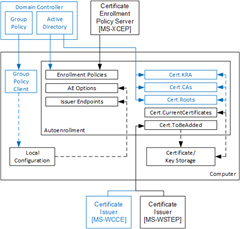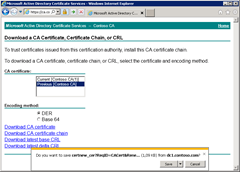Posts on this page:
- Certificate Autoenrollment in Windows Server 2016 (part 2)
- Certificate Autoenrollment in Windows Server 2016 (part 1)
- Install Certification Authority with PowerShell
- How to change CA certificate validity period
- You cannot download CA certificate from web enrollment pages
This is a second part of the Certificate Autoenrollment in Windows Server 2016 whitepaper. Other parts:
Certificate Autoenrollment Architecture
This section discusses the autoenrollment architecture, an analysis of the components of the autoenrollment process, and working with certificate authority interfaces.
Autoenrollment internal components
Autoenrollment consist of several components installed on each computer. Depending on environment (Active Directory or workgroup) some components may present or not present. The following diagram outlines autoenrollment components and their high-level interactions in both environments:

The meaning of each component is provided in next sections.
Group Policy client
This component is not available in workgroup environments.
Client module that is responsible for Group Policy retrieval and processing from domain controller, policy storage and policy maintenance on a local computer. Group Policy client updates local configuration with certificate enrollment policy (CEP) information.
Local configuration
System Registry storage that contains information about certificate enrollment policies (CEP). This information is then used to populate configuration for: Enrollment Policies, AE Options and Certificate Issuers components. Local configuration is stored in System Registry in HKLM and HKCU registry hives:
SOFTWARE\Policies\Microsoft\Cryptography\AutoEnrollment\
Enrollment Policies
Contains a collection of CEPs. In Active Directory environment, a LDAP domain policy is added by default. XCEP policies must be configured by an administrator in Group Policy on domain controllers (available only in Active Directory) and/or using local configuration tools. Each policy contains the following notable properties:
Read more →
Hello, everyone! Today I’m starting a new community whitepaper publication on certificate autoenrollment in Windows 10 and Windows Server 2016. This is a deeply rewritten version of the whitepaper published 15 years ago by David B. Cross: Certificate Autoenrollment in Windows XP. Certificate enrollment and autoenrollment was significantly changed since original whitepaper publication. Unfortunately, no efforts were made by Microsoft or community to update the topic. So I put some efforts in exploring the subject and writing a brand-new whitepaper-style document that will cover and reflect all recent changes in certificate autoenrollment subject.
This whitepaper is a structured compilation of a large number of Microsoft official documents and articles from TechNet and MSDN sites. Full reference document list and full-featured printable PDF version will be provided in the last post of this series.
Whitepaper uses the following structure:
- Certificate enrollment architecture
- Certificate autoenrollment architecture
- The autoenrollment process and task sequence
- Autoenrollment configuration
- Certificate autoenrollment in action
- Advanced features
- Troubleshooting
First post of the series will cover only general questions and certificate enrollment architecture. It is important to understand how certificate enrollment works in modern Windows operating systems, because autoenrollment heavily relies on this architecture. So, let’s start!
Read more →
Hi there! PowerShell Crypto Guy is again here!
Today I've finished SetupCA.ps1 script testing and I'm ready to share it with you. Of course this is not the first attempt to install CA role from cmdline, there is already SetupCA.vbs script written by Windows PKI team. To be honest, this is not the first PowerShell script for CA installation from cmdline. The first attempt was made by Hasain Alshakarti — http://secadmins.com/?dl_id=3. However this script just illustrates basic API functionality with ability to specify CA name, CA certificate validity and CA type. There is no error handling at all, even whether the CA can be installed on the computer.
Read more →
Today I want to discuss one question about CA certificate validity and how this can be changed.
Issue background
A little abstract. When you install Windows Certification Authority the default value is 5 years. It is quite long period and many young administrators leave default value (especially if they are not very experienced in certificate services). After a time it appears that 5 years is too short validity for CA certificate and administrators lookups for a resolution.
Read more →
SYMPTOMS
When you try to download CA certificate from web enrollment pages you get a prompt message with unreadable proposed file name:
Do you want to save certnew_cer?ReqID=CACert&Renewal=1&Enc=bin (1,09 KB) from <ServerName>
Read more →




